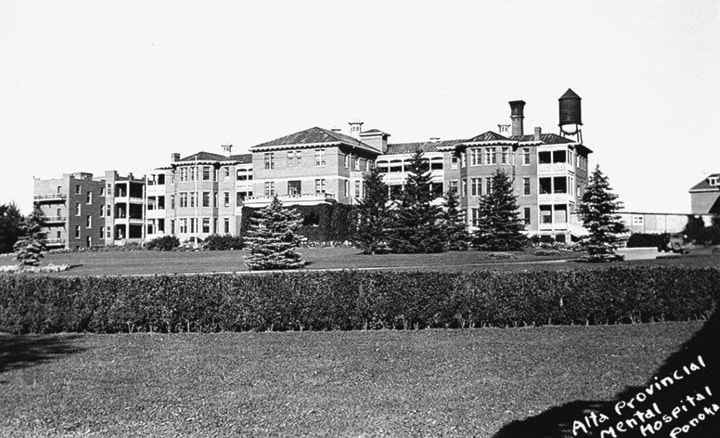For those of us who grew up in and around Ponoka in the 1950s/60s/70s, we watched the Provincial Mental Hospital grow at an overwhelming pace, were fortunate to become friends with so many of the staff and their families, and really appreciated how much that this first class Psychiatric treatment centre has complemented our community over the years.
The day-to-day team effort at PMH
Hospital furniture, patients’ clothing and linens were all made on site, as well as all the cooking and baking. The labour was all done by patients, under supervision of staff. Even some of the nursing care, feeding and meal service was done by patients, and in many ways this system worked very well. Patients were often able to work in their own trades and keeping busy, and contributing to the general wellbeing of the community was considered part of their therapy.
Also, many patients who perhaps could have been discharged, had no homes to go to, so were content to stay at the hospital where they had a secure and safe place to live. Many of these patients had what was called parole, and were free to do what they wanted when they weren’t at work, as long as they returned to their wards when the whistle blew for curfew. They were also given a small stipend for their work. I suppose that in some ways, one could say that the patients were exploited, but I think that life was much better for psychiatric patients from the hospitals than it is now, where so many are living on the streets and have no opportunity to participate in meaningful work.
At the entrance to the hospital grounds was a house for the supervisor of the septic tanks, which were across the road. In front of the main building were several acres of perfectly groomed flower beds, filled with multihued snapdragons, stocks, and asters. Walks of red gravel, with vine covered trellises and pergolas placed at regular intervals wound through the gardens, and in the fall, Chinese lantern plants whispered dryly in the chilly winds. The gardens were enclosed by meticulously clipped hedges of cotoneaster and honeysuckle. Beyond the last hedge were the fields of hay and in the later summer and fall there were wonderful haystacks on which children could climb, and then hide in all day, surveying the countryside unobserved by those unfortunates wandering around in the real world. In those simpler times, the children could disappear for an entire day and not be cause for any concern, unless they did not turn up for supper. Even then, parents were likely to assume that their child had stayed for supper at a neighbour’s, and wouldn’t begin seriously trying to track them down until bed time.
Like the inhabitants of a monastery, our lives as residents on the grounds too, were regulated, not by bells calling us to prayer, but by different kinds of bells and whistles. Early in the morning, at 8 the first whistle went. This one sounded like a steam locomotive whistle, and it signalled the beginning of the work day for some of the staff. The next one sounded at noon, to mark the beginning of lunch hour for all the office staff and maintenance workers, and again at one o’clock, to call them back to work. At five o’clock there was a whistle for the end of the work day, and at dusk, the train whistle sound again, to call in all the patients who had parole and were out on the hospital grounds. Sometimes there would be a series of blasts from another whistle, and this was to let everyone know when a patient had escaped from the hospital. It was four blasts for male patients and five for a female, and for some reason, patients escapes were called elopements.
Only a small percentage of the staff lived on the grounds. During the 1950s, the hospital housed about 1300 patients, and there were about 450 people on the payroll. There were about 40 children of school age living on the hospital grounds, and although we didn’t realize it at the time, our childhood experiences were unique. Because we were almost three miles from the town, and very few families had cars, we had to get along with each other if we wanted anyone to play with. So for the most part, we overlooked personality and age differences, and stuck together, but I suppose this was the case in any small rural community.
We had a bus to take us downtown to school, not once, but twice a day, for we came home for lunch. Lunch hour was one and a half hours, so there was plenty of time. Our fathers also came home at lunch time, to listen to the CBC news, and to eat a leisurely meal. In those days for most families, the noon meal was the main meal of the day. We knew it was time to run for the bus when the theme for the Proctor and Gamble Hour began. Please watch for more AHP memories later.
